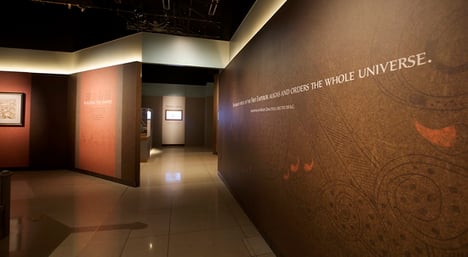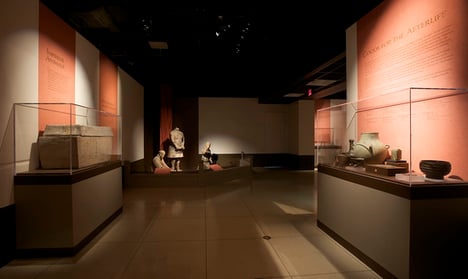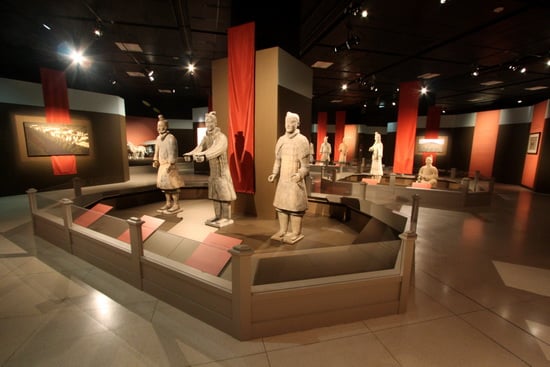If you are planning to visit Washington, DC anytime between now and the end of March, consider visiting the National Geographic Museum to check out an amazing exhibit entitled “Terra Cotta Warriors: Guardians of China’s First Emperor.” The reason we’re talking about it here is because the National Geographic Imaging Department used an Espon Stylus Pro GS6000 and LexJet Sunset Satin Canvas SUV to print many of the graphics and visuals that tell the story of the Terra Cotta Warriors and artifacts on display. Below are excerpts of an article that appeared in Vol. 4, No. 12 of LexJet’s Expand newsletter.
One of China’s most popular tourist destinations is near the city of Xi’an, where archaeologists are continuing to excavate a massive, subterranean vault containing fragments of thousands of life-size terra cotta figures produced more than 2,000 years ago. The figures were created to guard the tomb of China’s first emperor, Qin Shihuangdi, who ruled from 221 B.C. to 210 B.C.
More than 1,000 figures have been unearthed, and an estimated 6,000 more remain in the known underground pits. National Geographic magazine first published an article about these terra cotta warriors in 1978, after the first fragments were found four years earlier by farmers digging a well. The site is now regarded as one of the greatest archaeological discoveries of the 20th century.
When it was announced that some figures and artifacts from Qin Shihuangdi’s tomb would be available for display in the United States, the National Geographic Museum was one of four museums chosen to present an exhibition. Entitled “Terra Cotta Warriors: Guardians of China’s First Emperor,” the exhibit opened at the National Geographic Museum on Nov. 19 and runs through March 31, 2010. The 12,000-sq. ft. exhibition is organized in four rooms on the first floor of the headquarters of the National Geographic Society in Washington, DC.

The exhibit’s graphics and visuals were designed by Alan Parente, Art Director for the National Geographic Museum. Dozens of text panels, illustrations, and other supporting graphics were produced by Rob Naylor of the National Geographic Imaging Dept. which is managed by Bernard Quarrick.
About 95% of the graphics for this project were produced on the Epson Stylus Pro GS6000 low-solvent-ink printer that National Geographic’s Imaging Dept. had purchased from LexJet. The graphics include more than 75 large graphics panels printed on Sunset Select Satin Canvas SUV and 50 to 60 directional and informational signs printed on vinyl and posted inside and outside the museum.
“We were extremely excited to get this exhibition,” says Parente. “We were all honored to be able to work on it.”
Because of the tremendous costs involved in transporting and insuring the artifacts, and providing additional security, this is the first time the National Geographic Museum has sold tickets for an exhibition. When the exhibit opened in November, more than 100,000 advance tickets had already been sold.
Even though the artifacts had previously been shown at the Bowers Museum in Santa Ana, CA, the High Museum of Art in Atlanta, and the Houston Museum of Natural Science, Parente wanted to create a fresh design for the National Geographic Museum. He wanted to present the Terra Cotta Warriors in a way that would include the type of explanatory information that fans of National Geographic Society expect.
Parente chose earth tones for the color scheme to put the focus on the warriors themselves. He selected canvas as a no-sheen, natural-looking material for the entryway, explanatory text and supporting illustrations. Most of the text panels are applied directly to the walls. The illustrations were printed on canvas, stretched as gallery wraps, and hung on the wall.


The exhibit graphics were produced during an intense six-week period from early October through mid-November. During this time, the GS6000 ran nearly non-stop including nights and weekends.
“The printer got a real workout on this job,” says Naylor. “But it came through like a champ.” Naylor also used the GS6000 with calendered vinyl to print floor graphics, outdoor signs, and directional signs. He used LexJet Sunset Fine Art Satin SUV by Hahnemuhle to produce promotional prints that could be displayed in the windows of local retailers.

Producing graphics for the Terra Cotta Warriors exhibit enabled the National Geographic Imaging Department to demonstrate their full range of capabilities. Until now, most exhibits in the National Geographic Museum have featured the organization’s world-class images that show the richness and diversity of our world. Most of these images are printed on National Geographic’s Durst Lambda which uses RGB lasers to exposure images onto photo papers which are then fed through a silver-halide photo processor.
National Geographic Imaging is also equipped with a GBC Orca wide-format laminator and three Epson Stylus Pro 9800 printers which are used primarily to print maps and as proofing devices for National Geographic magazines and publications.
According to Quarrick, the graphics team at National Geographic Imaging can handle a wide range of exhibit-graphics work for other museums in the Washington, DC area. “We don’t like to turn down anything. What someone might consider a problem, we in National Geographic Imaging treat as a challenge,” says Quarrick.
Designer Alan Parente agrees that the Imaging Department has some very knowledgeable employees: “These guys are great partners to have. They are very creative in their own right. When I come to them with my ideas, I know I can rely on them to help me figure out how to make these things a reality.”
Naturally, everyone at LexJet is thrilled to see LexJet materials used in such a magnificent exhibit. Account specialist Jaimie Perez says, “I have been working with Rob for years, and was honored to help Rob find the perfect materials to fit their vision of the Terra Cotta Warriors exhibit.”
For more information about “Terra Cotta Warriors: Guardians of China’s First Emperor” exhibition, visit www.warriorsdc.org
For more information about using the Epson Stylus Pro GS6000 and LexJet materials to produce exhibit graphics and visuals, contact Jaimie Perez or any of the other helpful experts at LexJet ay 800-453-9538.

